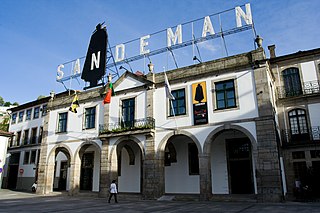
Vila Nova de Gaia, or simply Gaia, is a city and a municipality in Porto District in Norte Region, Portugal. It is located south of the city of Porto on the other side of the Douro River. The city proper had a population of 178,255 in 2001. The municipality has an area of 168.46 km². and a total population of 302,295 inhabitants (2011), making it the most populous municipality in Norte Region, and the third most populous in the country, after Lisbon and Sintra. Gaia along with Porto and 12 other municipalities make up the commonly designated Porto Metropolitan Area.

Soares dos Reis National Museum is a museum, currently housed in the Carrancas Palace situated in the civil parish of Cedofeita, Santo Ildefonso, Sé, Miragaia, São Nicolau e Vitória, in the northern Portuguese city of Porto.
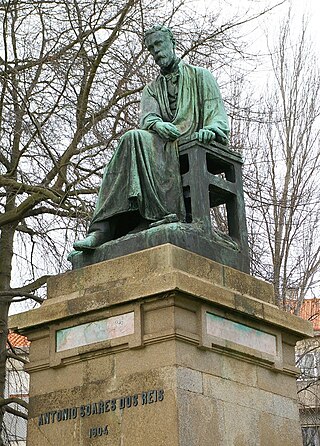
António Manuel Soares dos Reis was a Portuguese sculptor.
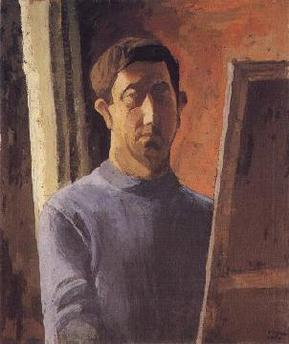
João Manuel Navarro Hogan was a Portuguese painter and printmaker.

António Teixeira Carneiro Júnior was a Portuguese painter, illustrator, poet and art professor.

Josefa de Óbidos was a Spanish-born Portuguese painter. Her birth name was Josefa de Ayala Figueira, but she signed her work as "Josefa em Óbidos" or "Josefa de Ayalla". All of her work was executed in Portugal, her father's native country, where she lived from the age of four. Approximately 150 works of art have been attributed to Josefa de Óbidos, making her one of the most prolific Baroque artists in Portugal.
Cristóvão de Figueiredo was a Portuguese Renaissance painter.
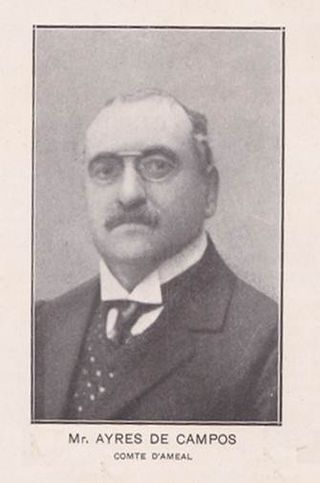
João Maria Correia Ayres de Campos, 1st Count of Ameal, GCC, CvNSC, OOPA was a Portuguese politician and antiquarian, best known as a great art collector, maecenas and bibliophile. He is renowned chiefly for having assembled one of Portugal's largest and most important private art collections, as well as what was at the time the largest private library in the country; his collections are also famous for having been auctioned en masse after his death in 1920, leading to the largest auction recorded in the Iberian Peninsula on that decade. Several pieces belonging to him have since been incorporated in the collections of the Louvre, the Prado, the Museu Nacional de Arte Antiga in Lisbon and the Soares dos Reis National Museum in Porto.

António Teixeira Lopes was a Portuguese sculptor.

The roots of Brazilian sculpture have been traced back to the late 16th century, emerging soon after the first settlements in the newly discovered land. Through the following century, most of the sculpture in Brazil was brought from Portugal and displayed Baroque features. The Baroque style would flourish within the religious culture of the country and would remain predominant until the first decades of the 19th century. In the 19th century, sculptural activity decreased, but it later revived when both the government and the public took a new interest in the art. Modernism fomented a period of intense research into a new language of sculpture, with great achievements, and the contemporary sculpture of Brazil enjoys worldwide respect.

The Palace of the Carrancas is a former-residence in the civil parish of Cedofeita, Santo Ildefonso, Sé, Miragaia, São Nicolau e Vitória, in the northern Portuguese city of Porto. It houses the Soares dos Reis National Museum.

The Museum-Residence of Dr. Anastácio Gonçalves is a former residential home built in the Art Nouveau style that has been converted into a museum of nineteenth-century Portuguese painting and of Art Nouveau art and artifacts. It is located in the civil parish of Avenidas Novas, in the municipality and Portuguese capital of Lisbon.
The Casa-Museu Marta Ortigão Sampaio is a small museum located in the city of Porto, Portugal. Marta was born in Porto into an upper-class family in end of 19th century, her father being a prominent intellectual, Vasco Ortigão Sampaio. She never actually lived in this house; her husband died prematurely during the construction of the house. Instead, she remained in the neighboring city of Matosinhos and became a collector of art in the vibrant bourgeois environment of Porto of the 19th century. The house exhibits impressive pieces of furniture as well as jewelry, painting and other art objects, including works of the Portuguese painters Silva Porto, Aurélia de Souza, Sofia Martins de Sousa and Marques de Oliveira.
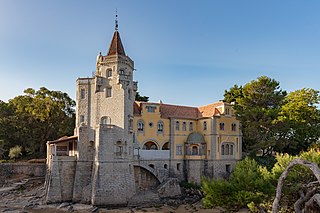
The Palácio dos Condes de Castro Guimarães, originally known as the Torre de São Sebastião, was built in 1900 as an aristocrat’s summer residence in Cascais, Lisbon District, Portugal. It became a museum in 1931. The building follows an eclectic architectural style, while the museum includes paintings of national and international significance, furniture, porcelain, jewellery and a neo-Gothic organ.

The Berardo - Art Deco Museum (B-MAD) is an Art Deco museum in Lisbon, capital of Portugal, that also displays Art Nouveau pieces that contribute to the understanding of Art Deco. It is an initiative of the Associação de Colecções, established by the Portuguese businessman, Joe Berardo. The museum opened to the public on 24 April 2021.
Azul no Azul is a short Portuguese experimental film created by Italian filmmaker Gianmarco Donaggio and Portuguese painter Nelson Ferreira. The film was produced and distributed in collaboration with the National Museum of Contemporary Art in Portugal, and it premiered at the museum on the 28th of July 2022, after which it was exhibited in the cinema of the museum from the 29th of July until the 15th of September 2022. A second version was created for Soares dos Reis National Museum to celebrate the 150 years of the sculpture ‘The Exiled’ by António Soares dos Reis and screened at the museum from the 10th of December 2022 until 19 March 2023. The city of Lucca projected it on a loop for a week. Listed by Berlinale Talents when the director was nominated as Talent in 2024. Art critic Simona Frigerio compared this film to Derek Jarman's last masterpiece Blue.

The Provincial Palace is located in the historic center of the city of Manaus, capital of the state of Amazonas. It is a centenary building where important events related to the social and political life of the people of Amazonas occurred.

Museu Allen, also referred to as the Museu da Restauração and the Museu Portuense da Rua da Restauração, was located in the parish of Miragaia, in the city and district of Porto, in Portugal. The first museum in Porto to offer public admission, it was dedicated to the exhibition of collections of art, natural history, epigraphs and other items owned by John Francis Allen (1781-1848), a wealthy port wine dealer, whose collection was, at the time, considered the best private collection in the country.















